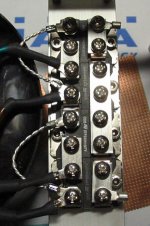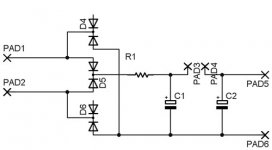hello Team!!
Ive read Schottky have the best sound chararistics.
Thinking of using MBR1645 for my dual bridge AX-100
but these are rated at 16A, 45v TO-220AC
Would like to go larger but having problems with the 3 pin schottky Diodes
I can find common cathode but no common Anode to make up a bridge.
IS 16A forward current enough on the MBR1645?
Me thinks it is
Thanks in advance
Dan
Ive read Schottky have the best sound chararistics.
Thinking of using MBR1645 for my dual bridge AX-100
but these are rated at 16A, 45v TO-220AC
Would like to go larger but having problems with the 3 pin schottky Diodes
I can find common cathode but no common Anode to make up a bridge.
IS 16A forward current enough on the MBR1645?
Me thinks it is

Thanks in advance
Dan
Dan,
As far as I know, there is no common-anode 3-pin schottky. To make a two unit full bridge, you will need to use the MUR1620CT and MUR1620CTR (common-cathode and common-anode, respectively). These ultrafast dual-unit rectifiers are made by OnSemi. I have used them in SMPSs for several years now, with good success.
Same types you would find in most car amps with PWM DC-DC converters.
Hope this helps!
Regards,
Steve
As far as I know, there is no common-anode 3-pin schottky. To make a two unit full bridge, you will need to use the MUR1620CT and MUR1620CTR (common-cathode and common-anode, respectively). These ultrafast dual-unit rectifiers are made by OnSemi. I have used them in SMPSs for several years now, with good success.
Same types you would find in most car amps with PWM DC-DC converters.
Hope this helps!
Regards,
Steve
How about switch diods,like Byv26 or Byw95 wich im using,any diffrence in sound?Thowe not as powerful as 16A.Ive read Schottky have the best sound chararistics.
Hello William
Have you priced these puppies!!!
If i remember correctly you purchased from the Trading Post.
Have you priced these puppies!!!
If i remember correctly you purchased from the Trading Post.
NP said he is using BYW99W-200 in the XA series.
These are three pin common cathode
Just how do you make a bridge with only common cathode??
This is causing some headache!!
These are three pin common cathode
Just how do you make a bridge with only common cathode??
This is causing some headache!!
freakyone said:
Just how do you make a bridge with only common cathode??
Put the (dual) diodes in paralell...
freakyone said:Just how do you make a bridge with only common cathode??
This is causing some headache!!
Use 3. 😉
Looks good to me. In my earlier email, I stated that I knew of no common-anode dual-Schottky when I should have said common-anode. Got reversed in my terminology. Also, I forgot to say that you could use four (or three, in the case here) three common-anode Schottkys to do the same thing.
In the past, when I wanted to use Schottkys for dual (+/-) SMPSs, I simply used four MBR20200CT dual Schottkys (20A , 200PIV) in conventional bridge fashion, just paralleling their two diodes as Mad-K suggested.
This gave me only a couple percentage points improvement in efficiency, but at levels 500W and above, every little bit counts.
In the past, when I wanted to use Schottkys for dual (+/-) SMPSs, I simply used four MBR20200CT dual Schottkys (20A , 200PIV) in conventional bridge fashion, just paralleling their two diodes as Mad-K suggested.
This gave me only a couple percentage points improvement in efficiency, but at levels 500W and above, every little bit counts.
Hi freakyone, thank you for this thread. I just finished this common cathode schottky bridge based on your excellent .gif you posted.
http://www.diyaudio.com/forums/showthread.php?postid=908648#post908648
It is a simple 300B filament supply, pads 3 & 4 on the top are for a filament choke that is to big for the board.
think it will fly...
http://www.diyaudio.com/forums/showthread.php?postid=908648#post908648
It is a simple 300B filament supply, pads 3 & 4 on the top are for a filament choke that is to big for the board.
think it will fly...
Attachments
Can anybody tell me the difference between a Schotky and a Fast Recovery/Ultra fast diode. I get confused as very low Trr (25-50ns) is mentioned in the datasheets of UF/FR diodes, where as there is no mention of trr on Schotky datasheets.
Or why is it used differently.
Thanx in advance.
Or why is it used differently.
Thanx in advance.
Well, Basically, the schotky diodes have extremlly low forward voltage. Hence the better effeciency mentioned. They have capacitance though. in some applications that is unacceptable. I can't comment on sound though, havent been there yet...
The "Fast and Ultra Fast" Diodes are low capacitance, usfull for switching supplies and such. They do not cause "switching" losses which can cause more problems thatn a higher forward votlage.
Forward voltage is probably not to big an issue for us +or- a Volt???
I havent totally understood whats better than a normal diode when you talking 60Hz though😕 😕 😕
The "Fast and Ultra Fast" Diodes are low capacitance, usfull for switching supplies and such. They do not cause "switching" losses which can cause more problems thatn a higher forward votlage.
Forward voltage is probably not to big an issue for us +or- a Volt???
I havent totally understood whats better than a normal diode when you talking 60Hz though😕 😕 😕
Schottky diodes are constructed differently than regular PN devices. They deal directly with electrons rather than "holes".
Recovery time is a term that should not really applied to Schottky's. There is capacitance to deal with but not recovery in the same sense as it is applied to PN diodes.
Schottky PRO's:
* Low forward drop (this advantage falls away with high reverse voltage specs).
* Minimal reverse recovery effects (fast).
Schottky CON's:
* Higher reverse leakage
* Higher capacitance
* Limited to lower voltage applications
* Higher bulk resistance
Despite the fact that high voltage Schottkys have no advantage in forward drop, development of higher reverse voltage types continues because of the better switching characteristics.
🙂
Recovery time is a term that should not really applied to Schottky's. There is capacitance to deal with but not recovery in the same sense as it is applied to PN diodes.
Schottky PRO's:
* Low forward drop (this advantage falls away with high reverse voltage specs).
* Minimal reverse recovery effects (fast).
Schottky CON's:
* Higher reverse leakage
* Higher capacitance
* Limited to lower voltage applications
* Higher bulk resistance
Despite the fact that high voltage Schottkys have no advantage in forward drop, development of higher reverse voltage types continues because of the better switching characteristics.
🙂
Poobah, Pro's & Con's, Hole's & Eletectrons, asside, can you comment on how the 50-60Hz linear supply rectification is effected by either of these component types. Or, how something other than a "general purpose diode" type may provide listening benifits??? Thanks





I personally think that if diode hash is getting through your supply than the supply needs more work.
I wouldn't use Schottkys because of the cost, and they're relatively fragile.
The reverse rating of the Schottky is not forgiving at all. A few Volts "over the line", for few nanoseconds, and you're out. One good glitch from the power line will do this. Hell, you can blow one up walking across a carpet!
There is a "UF" series of diodes that is recommended by many here... Check out a UF4004. A fast diode still makes noise... it just pushes some of noise up to higher frequencies; where it is presumably easier to kill.
There is also a thread here somewhere about diode noise... maybe one of the Mods will recall it. When all is said and done, refer to the first sentence^.
Putting a small capacitor across the diodes is also a common trick.
🙂
I wouldn't use Schottkys because of the cost, and they're relatively fragile.
The reverse rating of the Schottky is not forgiving at all. A few Volts "over the line", for few nanoseconds, and you're out. One good glitch from the power line will do this. Hell, you can blow one up walking across a carpet!
There is a "UF" series of diodes that is recommended by many here... Check out a UF4004. A fast diode still makes noise... it just pushes some of noise up to higher frequencies; where it is presumably easier to kill.
There is also a thread here somewhere about diode noise... maybe one of the Mods will recall it. When all is said and done, refer to the first sentence^.
Putting a small capacitor across the diodes is also a common trick.
🙂
Well, it appears that most diodes are noisy at low currernts but Schotky's are better than most. At the 0 crossing area of your AC wave where there is low current and votage the schotky should be an improvement. That is, if you can deal with the sensitivity to distruction issue where it appears to be the least suited.
A more robust component with snubbers sounds like the place to start for me...
I stll have trouble understanding if this tiny little noise on the other end of all this inductance and capacitance is going to show up with any strength at the PCB or the output...
A more robust component with snubbers sounds like the place to start for me...
I stll have trouble understanding if this tiny little noise on the other end of all this inductance and capacitance is going to show up with any strength at the PCB or the output...
Hash can fly right through inductors because of the capacitors formed between each individual winding. The same applies to electrolyics because of their ESR and ESL.
If you finish the tail of your supply with good film or ceramic caps, you can kill it.
Also ferrites beads work well in this regard, and I don't know why I don't see more reference to them here.
A good UF series diode, snubbed will do you right.
😉
If you finish the tail of your supply with good film or ceramic caps, you can kill it.
Also ferrites beads work well in this regard, and I don't know why I don't see more reference to them here.
A good UF series diode, snubbed will do you right.
😉
- Status
- Not open for further replies.
- Home
- Amplifiers
- Pass Labs
- what schottky have been used?

